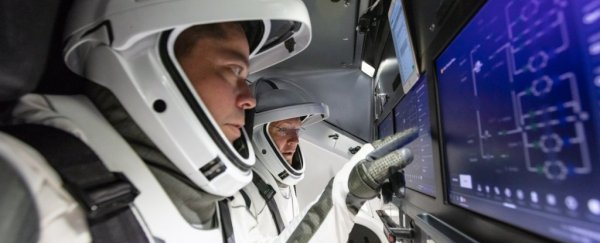Elon Musk founded SpaceX in 2002 with the goal of populating outer space. But in the nearly 18 years since – and even as the rocket company continues to disrupt the global launch industry – the most complex life-form SpaceX has flown is a mouse.
That should all change in early 2020, though, as SpaceX prepares to launch its first crewed mission aboard its new capsule-like spaceship, called Crew Dragon.
The NASA astronauts and spaceflight veterans Bob Behnken and Doug Hurley are set to board the Crew Dragon, rocket into orbit 250 miles above Earth, and dock with the football-field-size International Space Station.
In anticipation of that critical flight, called Demo-2 – the second orbital demonstration of the spaceship for NASA – Musk on Sunday night tweeted a computer-rendered video showing what it'd be like to ride the vehicle. SpaceX later shared the full clip on YouTube.
In the video, two astronauts trot down a sleek launchpad walkway in Cape Canaveral, Florida, climb aboard a Crew Dragon, and rocket into orbit atop a Falcon 9 rocket.
The ship docks with the ISS and later detaches. After jettisoning a "trunk" that helped it reach the space station, the Crew Dragon capsule and its human passengers blaze home as the vehicle's heat shield plows through Earth's atmosphere at about 25 times the speed of sound.
SpaceX has been working toward this goal for the better part of a decade, and Musk seemed to be feeling sentimental about the upcoming moment; just before sharing the new clip, Musk tweeted a simulation from 2011 that shows an early design of a Dragon ship going through similar paces.
"8 years later, the simulation is mostly real," Musk said.
'We are on the brink of launching American astronauts from American rockets on American soil'
NASA has asked SpaceX to pull off the upcoming mission as part of its Commercial Crew Program, a government competition that began in 2010. The program's goal is to resurrect US cargo and crew services for the space agency, which retired its space-shuttle fleet in July 2011, and to avoid having to buy astronauts tickets aboard Russian rockets.
"For the first time since 2011, we are on the brink of launching American astronauts from American rockets on American soil," NASA Administrator Jim Bridenstine said during the official debut of Behnken, Hurley, and other Commercial Crew astronauts in August 2018.
SpaceX was supposed to launch astronauts before the end of 2017, though, prompting Bridenstine to publicly complain just before Musk presented a different and forthcoming launch system, called Starship.
"Commercial Crew is years behind schedule. NASA expects to see the same level of enthusiasm focused on the investments of the American taxpayer," Bridenstine tweeted in a statement on September 27. "It's time to deliver."
Boeing is the other finalist in NASA's commercial competition, with its CST-100 Starliner spaceship.
Starliner has passed a long list of tough tests, including launching into orbit without any people inside and safely returning to Earth. But during that mission, in late December, the vehicle suffered a critical clock error that led to the Starliner unnecessarily burning up much of its fuel.
To save the uncrewed ship from total failure, Boeing skipped its docking with the ISS – the main objective of its mission, called the Orbital Flight Test – and used the remaining propellant to stabilise its orbit and return home.
Neither Boeing nor SpaceX has a firm date for launching its first astronauts. However, given the recent issue with Starliner, SpaceX seems poised to fulfil NASA's goal first.
The company must first complete a launch-escape system test, scheduled for early January. If it goes well, Musk said on Sunday, the Crew Dragon ship for the Demo-2 mission "should be physically ready" for launch in February, and "completing all safety reviews will probably take a few more months," or around May.
Demo-2's success would pave the way for SpaceX to launch an earnest and extended follow-on crewed mission to the ISS with the NASA astronauts Mike Hopkins and Victor Glover.
This article was originally published by Business Insider.
More from Business Insider:
